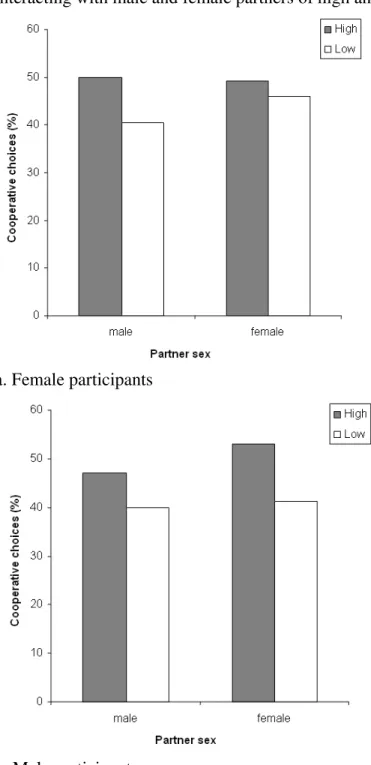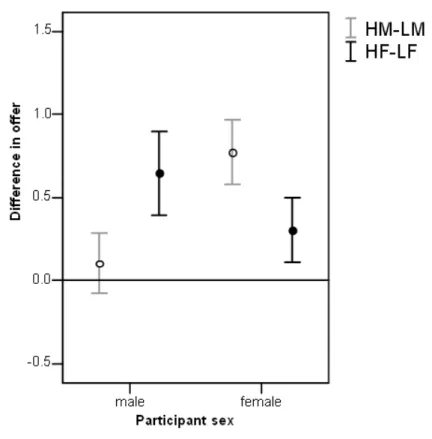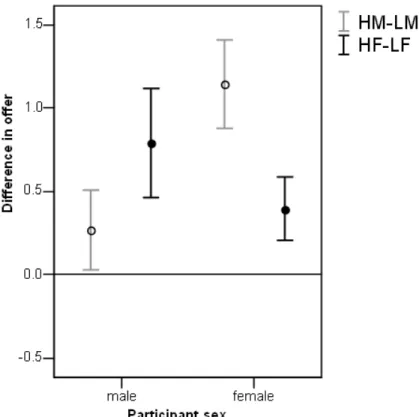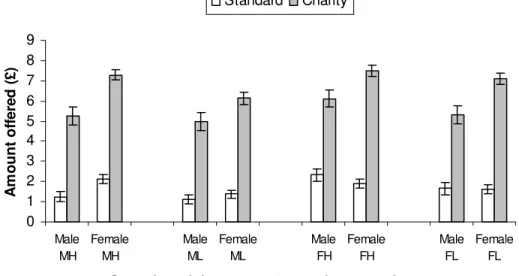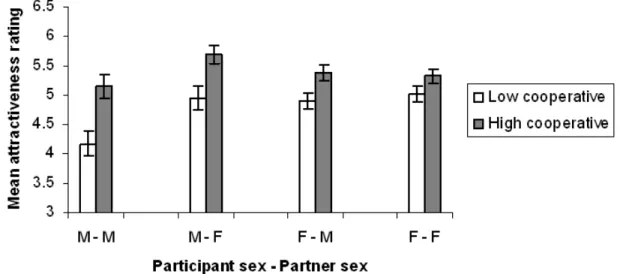www.epjournal.net – 2007. 5(2): 313-329
¯ ¯ ¯ ¯ ¯ ¯ ¯ ¯ ¯ ¯ ¯ ¯ ¯ ¯ ¯ ¯ ¯ ¯ ¯ ¯ ¯ ¯ ¯ ¯ ¯ ¯ ¯ ¯
Original Article
Altruists Attract
Daniel Farrelly, School of Biology (Psychology), Newcastle University, Newcastle-upon-Tyne, UK. Email:
daniel.farrelly@sunderland.ac.uk (Corresponding author) (Current address: Department of Psychology, University of Sunderland, Sunderland, UK.)
John Lazarus, School of Biology (Psychology), Newcastle University, Newcastle-upon-Tyne, UK. Gilbert Roberts, School of Biology (Psychology), Newcastle University, Newcastle-upon-Tyne, UK.
Abstract: Explaining human cooperation continues to present a challenge because it goes beyond what is predicted by established theories of kinship and reciprocal altruism. Little attention has been paid to the sexual selection hypothesis that proposes that cooperation can act as a display that attracts mates. The costs of cooperating are then offset not by kinship or reciprocation but by increased mating success. Here we present results from a series of experiments which show that, as predicted by the sexual selection hypothesis, people preferentially direct cooperative behavior towards more attractive members of the opposite sex. Furthermore, cooperative behavior increases the perceived attractiveness of the cooperator. Economically costly behaviors can therefore bring benefits through mate choice and sexual selection should be regarded as an evolutionary mechanism capable of promoting cooperation.
Keywords: Altruism, cooperation, sexual selection, attractiveness.
¯ ¯ ¯ ¯ ¯ ¯ ¯ ¯ ¯ ¯ ¯ ¯ ¯ ¯ ¯ ¯ ¯ ¯ ¯ ¯ ¯ ¯ ¯ ¯ ¯ ¯ ¯ ¯ ¯ ¯ ¯ ¯ ¯ ¯ ¯ ¯ ¯ ¯ ¯ ¯ ¯ ¯ ¯ ¯ ¯ ¯ ¯ ¯ ¯ ¯ ¯ ¯ ¯ ¯ ¯ ¯ ¯ ¯ ¯ ¯ ¯ ¯ ¯ ¯ ¯ ¯ ¯ ¯ ¯ ¯ ¯ ¯
Introduction
Richerson, 2003). It has also been proposed that cooperation and altruism sometimes function as sexually selected displays that attract mates, either directly or through reputation (Miller, 2000; Roberts, 1998; Tessman, 1995; Zahavi, 1995). This last proposal has received little empirical testing and is the focus of our paper.
Sexual selection is responsible for traits ranging from complex songs to elaborate ornamentation, which are advertised to potential mates (Andersson, 1994). Like many such traits, altruism is, by definition, costly and therefore deleterious to survival. However, just as these other traits function in courtship, so altruism could function as a sexual display (Miller, 2000; Roberts, 1998; Tessman, 1995; Zahavi, 1995). Investment in altruistic displays would then reap rewards not through reciprocation or increased survival of relatives but through enhanced mating success. As in other cases of sexually-selected characters, the benefits of attending to the display of altruism could come through those that accrue from mating with high quality individuals. Altruism is a valuable trait in both males and females, in the long-term relationships of humans, since it allows the efficient sharing of resources - gained by either adult in the partnership - between both adults and their offspring, in response to need.
Models based on Zahavi’s Handicap Principle (Zahavi, 1995) show that altruism
can be favored when it acts as a costly signal of quality (Gintis, Smith, and Bowles, 2001; Lotem, Fishman, and Stone, 2003). Signalers (altruists) benefit through improving their reputation, which attracts mates; mates benefit through obtaining information about partner quality; and signal honesty is assured through condition dependence. An important feature of the signaling hypothesis is that it can explain acts of altruism that are not reciprocated, either directly or indirectly. It is important to appreciate the difference between reciprocity and signaling here. Reciprocal altruism, whether direct or indirect, involves two individuals benefiting others at some cost to themselves. Unless one is to argue that mating is an altruistic act that reduces one’s fitness, then preferring to mate with an altruistic individual cannot be considered to be an example of reciprocity, whether direct or indirect. To extend Haldane’s famous remark, kinship can explain rescuing drowning people if they are relatives (Hamilton, 1964); reciprocal altruism if they return the favor (Trivers, 1971); indirect reciprocity if a third party returns the favor (Alexander, 1987) and signaling if the rescuer is judged more attractive (Roberts, 1998).
of the quality of potential mates on the signaling of cooperative and altruistic motivation.
We are not concerned with the signaling of the ability to give (i.e. resource wealth) and
therefore hold this factor constant in the experiments.
We tested four key predictions of the sexual selection hypothesis that altruism or cooperation is a signal to potential mates using a series of experimental cooperation games. First, participants should be more cooperative with individuals of the opposite sex. Second, participants should be more cooperative when opposite sex partners are more attractive, and therefore of higher mate quality. Third, the strength of the signal should increase with the strength of sexual selection. Therefore, as females are the choosier sex, males are under stronger sexual selection and should therefore show a stronger cooperative bias in the first two predictions. Finally, for the signal to benefit the signaler, receivers should be more likely to mate with signalers. Thus more cooperative partners should be judged to be more attractive.
Materials and Methods
Our experiment involved asking participants to play a series of cooperative game scenarios with a series of partners differing in sex and attractiveness. Partners were presented as facial images in a web-based interface (faces being key components of attractiveness judgements, e.g. Penton-Voak et al., 1999). Participants were led to believe they were interacting with other participants in the experiment, although in fact the partners were virtual and their responses pre-programmed. Also, participants were told that they would be able to contact any individual they would interact with in the study privately in the future, via e-mail (however this was not true; participants were informed of this deception at the end of the study). This possibility of future interactions created an environment in which mate choice displays could be expected to occur.
There were 231 participants; 85 males (mean age=24.4, SD=6.4) and 146 females
(mean age=22.8, SD=5.2). Participants were students at Newcastle University and took part
voluntarily. They were recruited via e-mails to several degree programmes and posters placed around the university campus. As an incentive for participating, there were cash prizes of £25 for each of two participants, selected at random. The ethics committee of Newcastle University approved the experimental protocol. All participants gave informed consent online before the experiment began.
(cooperating), regardless of what their partner does. This leaves no room for displaying altruism, and the game tests whether participants have the understanding and motivation to behave in their economic interests. In the one-shot Prisoner’s Dilemma (PD) game, the rational decision is defection (e.g. Colman, 1998), but cooperation is the rational choice for those who have a sense of fairness (Fehr and Fischbacher, 2002) and who trust the partner also to cooperate. An alternative explanation for cooperating in this game is that it displays a cooperative tendency towards the partner even if this is costly. In the Dictator game, it is again rational to offer nothing, so giving may reflect a sense of fairness, or generosity. We also adapted the Dictator game to a scenario in which participants were told their offers would go to charity rather than the partner. Again, this allows displays of altruism, but differs in that the beneficiary is not the partner, emphasizing the signaling aspect of altruism. We refer to these two versions of the Dictator game as the standard Dictator (SD) and charity Dictator (CD) games. As well as the rational choices stated above it is always possible that participants have not understood the games and act under misguided notions of the consequences of their actions. However, the games were straightforward and instructions clear.
Participants played these four games against four other individuals (one each of the MH, ML, FH and FL images), playing all four games with each individual. The instructions for all the games were presented to the participants at the start. In the mutualism game, participants started with an imaginary amount of £10 and were told that if they donated £10 to a public fund and their partner did too, then both would receive £20 in return. They were also told that if only one or neither player donated, then each would either keep or have their £10 returned to them. In the one-shot PD game, participants again started with an imaginary amount of £10 and were told that if they donated £10 to a public fund and their partner did as well, each would receive £14; if one player donated and the other did not, the donor received only £7 whereas the other player received £17; and if neither player donated they would each keep their initial £10. In the SD game, participants were told: “In this game, you should imagine the following scenario: You are out shopping one afternoon. You spot a £10 note on the ground. After you pick up the note, an individual walks up to you and says, ‘Aah!! You beat me to it! I spotted the note too, and was about to pick it up myself.’ How much would you offer them (anything from £0 to £10)?” The CD game used the same instructions, except that the penultimate sentence read: “After you pick up the note, an individual walks up to you and says, ‘Aah!! You beat me to it! I spotted the note too, and was about to pick it up myself and give it to the charity I am collecting for. It would help us greatly’” (in both the SD and CD game, participants were told that the individual referred to in the scenario was the same as the individual in the current photo).
attributes in total and they were ‘intelligence’, ‘attractiveness’, ‘cooperativeness’ and ‘interesting’. Only the ratings of attractiveness were relevant here, the remaining characteristics being included to disguise the aims of the study and reduce demand characteristics. In each game, participants were asked to make a decision (either ‘give’ or ‘keep’ in the mutualism and PD game, or to invest between £0 and £10 in the two Dictator games). The picture of the current partner was on the screen throughout each game. Once all the games had been completed, participants were presented with the decisions that each partner had supposedly made in these games.
Participants were allocated randomly to one of two conditions; in one condition all partners had been highly cooperative when they played the game (74 females, 50 males) and in the other condition they had been less cooperative (72 females, 35 males) (Table 1). Finally, participants rated each partner again for intelligence, attractiveness, cooperativeness and how interesting they thought they were. Afterwards, participants received a full de-briefing about the experiment in an e-mail.
Table 1: The decisions of partners for each cooperativeness condition.
Game Highly cooperative Less cooperative
Mutualism Invest Keep
One-off Prisoner’s Dilemma Invest Keep
Standard Dictator Offer £5 Offer £2
Charity Dictator Offer £5 Offer £2
Due to the within-subject design of the experiments, paired tests were used where appropriate. Non-parametric tests were used when data diverged from a normal distribution or when analyzing ratings. All significance levels are for two-tailed tests.
Results
In the mutualism game, all participants chose to donate. In the one-shot PD game, neither males nor females showed a sex bias in their tendency to cooperate (Wilcoxon matched pairs test between the sums of cooperative moves to female versus male partners by female participants: Z=-0.744, N-ties=53, p=0.457, and by male participants: Z=-0.860,
N-ties=24, p=0.390). However, both sexes cooperated more with more attractive members
of the opposite sex (Fig. 1): males were more likely to cooperate with an FH as opposed to
an FL partner (McNemar test: binomial, N=85, p=0.04), while females were more likely to
cooperate with an MH than with an ML partner (McNemar test:
χ
2=4.694, N=146, p=0.03).In neither sex was there a significant effect of attractiveness on cooperation towards
partners of their own sex (female participants with FH versus FL partners:
χ
2= 0.39,N=146, p=0.532; male participants with MH versus ML partners: binomial, N=146,
Figure 1: Percentage of cooperative choices made in a one-shot Prisoner’s Dilemma game for (a) female and (b) male participants. Bars show percentage of cooperative choices when interacting with male and female partners of high and low attractiveness.
a. Female participants
b. Male participants
In the SD game, males showed a strong preference for giving to females rather than
other males (Wilcoxon Matched Pairs Test: Z=4.564, N-ties=33, p<0.0005; Fig. 2a) but
showed a preference for giving to more attractive members of the opposite sex (male
participants with FH versus FL partners: Z=2.594, N-ties=24, p=0.009; female participants
with MH versus ML partners: Z=3.723, N-ties=39, p<0.0005; Fig. 3a), yet showed no
attractiveness preference when giving to their own sex (male participants with MH versus
ML partners: Z=0.548, N-ties=17, p=0.583; female participants with FH versus FL
partners: Z=1.559, N-ties=26, p=0.119; Fig. 3a).
Figure 2: Sex preferences in offers in (a) the Standard Dictator and (b) the Charity Dictator Game. The figure shows the mean differences (± standard error) in the offers made to female versus male partners, calculated as the sum of offers made to high and low attractiveness females minus the sum of offers made to high and low attractiveness males, for male and female participants respectively.
Figure 3: Mean differences in offer (high-low, ± standard error) between high and low attractive male partners (HM and LM) and between high and low attractive female partners (HF and LF) for male and female participants respectively in (a) the Standard Dictator and (b) the Charity Dictator game.
b. Charity Dictator Game
Much higher offers were given in the CD than the SD game (Z=-12.199,
N-ties=200, p<0.0005, Fig. 4). Nevertheless, there was a similar pattern: as in the SD game,
males gave more to females than to males (Z=-2.321, N-ties=33, p=0.020; Fig. 2b),
although unlike the SD game females also gave more to female partners than to males (Z
=-3.608, N-ties=51, p<0.0005; Fig. 2b). Attractiveness effects were similar to the SD game
with females preferring high over low attractive males (Z=-4.000, N-ties=45, p<0.0005;
Fig. 3b) and males preferring high over low attractive females (Z=-2.371, N-ties=28,
p=0.018; Fig. 3b). Again neither sex showed an attractiveness bias when interacting with
Figure 4: Mean (± standard error) amount offered in standard versus charity version of the dictator game. 0 1 2 3 4 5 6 7 8 9 Male MH Female MH Male ML Female ML Male FH Female FH Male FL Female FL
Sex of participant - sex/attractiveness of partner
A m o unt of fe re d ( £ ) Standard Charity
The predicted effects of sex and attractiveness on cooperative behavior were compared between the SD and CD games. The only significant difference between the games was that in females the favoring of female over male partners in the CD game was significantly greater than in the SD game (in which females gave equally to the two sexes)
(Wilcoxon Matched Pairs Test: Z=-2.806, N-ties=77, p=0.005).
Our third prediction was that males, more than females, would favor: (a) the
opposite sex over the same sex, and (b) more attractive members of the opposite sex over less attractive members of the opposite sex. The first of these two predictions was
supported for the SD game (Mann-Whitney test: Z=-4.105, N1=85, N2=146, p<0.0005) and
the CD game (Z=-4.232, N1=85, N2=146, p<0.0005) but not for the one-shot PD game (Z
=-1.288, N1=85, N2=146, p=0.198). The second of these two predictions, that males would be
more cooperative than females with more attractive members of the opposite sex than less
attractive ones, was not supported by the SD game (Z=-0.484, N1=85, N2=146, p=0.628),
the CD game (Z=-0.651, N1=85, N2=146, p=0.515) or the one-shot PD game (Z=-0.314,
N1=85, N2=146, p=0.754).
To investigate our fourth prediction, that more cooperative partners would be judged to be more attractive we had two conditions, one in which all partners of a participant cooperated generously and another in which all partners were less cooperative. Each participant rated each partner for attractiveness both before and after interaction. Our prediction was supported by participants’ ratings of partners’ attractiveness after playing the games (Fig. 5). The more generous partners were rated as more attractive in every case: males rating female (Z=-5.575, N1=50, N2=35, p<0.0005) and male partners (Z=-6.10,
Figure 5: Mean (± standard error) attractiveness ratings of male and female virtual partners of either high or low cooperativeness after interactions, plotted separately for male and female participants. M-F = Male participant, female partner, etc.
Analyzing the differences between attractiveness ratings before and after interaction, we found that attractiveness of partners in the high cooperation condition tended to increase, while those in the low cooperation condition tended to decline (Fig. 6). In the high cooperation condition males increased their attractiveness ratings for FH
(Wilcoxon matched pairs: Z=-2.349, N-ties=19, p=0.019) and FL (Z=-2.147, N-ties=15,
p=0.032) partners, but not MH (Z=-0.905, N-ties=16, p=0.365) or ML partners ( Z=-1.912,
N-ties=21, p=0.056), while females increased their ratings for ML (Z=-2.856, N-ties=32,
p=0.004), FL (Z=-2.198, N-ties=28, p=0.028) and FH partners (Z=-2.450, N-ties=28,
p=0.014) but not for MH partners (Z=-1.333, N-ties=31, p=0.182). In the low
cooperativeness condition males decreased their ratings for MH only (Z=-2.862, N-ties=12,
p=0.004) but not ML (Z=-0.258, N-ties=12, p=0.796), FH (Z=-1.411, N-ties=16, p=0.158)
or FL partners (Z=-1.162, N-ties=20, p=0.245) while females decreased their ratings for all
but ML partners (MH Z=-3.070, N-ties=34, p=0.002; FH Z=-4.151, N-ties=40, p<0.0005;
Figure 6: Mean (± standard error) differences in attractiveness ratings before and after interaction (after-before) with virtual partners of either high or low cooperativeness, plotted separately for male and female participants. The figure shows differences calculated for each participant across the four partner types against which they each played.
High Low
Partner cooperativeness
-0.40 -0.20 0.00 0.20
Mean
d
ifferen
ce in
attractiv
en
ess r
a
tin
g
Male Female Participants
Finally, we replicated analyses for individual image sets to ascertain whether our results were unduly influenced by the data from just one image set. We found that no single image set produced results consistently at odds with the others.
Discussion
sexes when attractiveness was taken into account. Finally, as predicted, more cooperative partners were rated as more attractive. This means that investment in altruism can pay off with an increase in perceived attractiveness and consequently in mating opportunity. Therefore relatively minor economic costs might bring large reproductive rewards.
In our experiments, an altruistic act provides a direct benefit to a recipient. As such, altruistic acts towards attractive opposite sex partners could be seen as “courtship gifts” whose primary function is in provisioning, as in some arthropod species (e.g. Simmons, 1995). However, a transfer of resources inevitably also provides information concerning both the present ability to acquire such resources and the willingness to give them away and, by inference, the same ability and willingness in the future (Lotem, Wagner, and Balshine-Earn, 1999). Altruistic acts can therefore be interpreted as signals whose function is to increase the attractiveness of the altruist to the receiver. It has been argued that cooperative signals may be particularly effective when they involve such direct benefits to a receiver (Roberts, 1998; Smith and Bliege Bird, 2005). However, if the recipient of the altruism and the receiver of the signal are the same, it can be difficult to separate the two functional explanations for altruism.
In support of the signaling hypothesis, the primary function of courtship gifts may be to convey information rather than provision mates. While some insect species provide gifts of nutritional value, this is by no means always the case (Sozou and Seymour, 2005) and human courtship gifts tend to be of low intrinsic value to the recipient (Miller, 2000). Recent models have shown that selection can favor male gifts that are costly but of little value to the recipient since this signals future investment by the male while avoiding exploitation by female “gold-diggers” (Bolle, 2001; Sozou and Seymour, 2005). And if the altruist and recipient form a long-term mating relationship the information content of a courtship gift is likely to be more valuable to the recipient than its intrinsic value, since the material benefit of the future cumulative generosity of the recipient, as predicted by the size of the gift, will far outweigh that of the gift itself. Thus honest signaling of generosity during human courtship, and in circumstances where it can reach potential mates by reputation, should be favored by selection. It also follows that the signaling function of altruism in the mating context will be more important in species with parental care and care of the mate, than in promiscuous species.
motives and emotions for altruism, and that altruistic behavior is also modulated adaptively by apparent costs and rewards, and by sex and attractiveness. This interpretation is supported by the finding that people will pick up on subtle cues and behave as if being watched even when they believe they are acting anonymously (e.g. Bateson, Nettle, and Roberts, 2006; Haley and Fessler, 2005).
A possible alternative explanation for the finding that attractiveness enhances cooperation is that people judge attractive individuals to be more cooperative (or are assigned other positive attributes due to the ‘halo effect’ Nisbett and Wilson, 1977) and cooperate more with them since they are more confident that their cooperation will be reciprocated. However, the greater cooperation that occurs with more attractive individuals in all these games only occurs for opposite sex partners. A meta-analysis shows that there is no effect of sex of target or sex of judge on the halo effect (Eagly et al., 1991). It is therefore not a parsimonious explanation for our findings.
Currently there is much debate concerning the apparently over-developed cooperativeness of humans (Gintis, Bowles, Boyd, and Fehr, 2005), notably in experimental game scenarios, and whether gene-based theories are adequate to explain such behavior (Fehr and Fischbacher, 2003). People do not seem to behave as predicted by economic rationality (Colman, 2003). Explaining human cooperativeness remains a challenge that will require integrating a number of different theories. Our results suggest that mate attraction should be considered as one contributory factor. As we show, altruism can bring advantages because altruists are attractive.
Acknowledgements: DF was funded by an EPSRC studentship; GR was funded by the JIF/Wellcome Trust and BBSRC. We thank Ian Penton-Voak who supplied the images, and also Satoshi Kanazawa and an anonymous reviewer for their helpful comments; we also thank our participants.
Received 26 January 2007; Revision submitted 26 April 2007; Accepted 27 April 2007
References
Alexander, R. D. (1987). The Biology of Moral Systems. New York: Aldine De Gruyter.
Andersson, M. (1994). Sexual Selection. Princeton: Princeton University Press.
Bateson, M., Nettle, D., and Roberts, G. (2006). Cues of being watched enhance cooperation in a real-world setting. Biology Letters, 2, 412-414.
Ben-Ner, A., and Levy O. (2005). Economic and hypothetical dictator game experiments:
Incentive effects at the individual level. Working Papers 0305. Industrial Relations Center, University of Minnesota (Twin Cities Campus).
Bolle, F. (2001). Why to buy your darling flowers: On cooperation and exploitation.
Theory and Decision, 50: 1-28.
Boyd, R., Gintis, H., Bowles, S., and Richerson, P.J. (2003). The evolution of altruistic
tested in 37 cultures. Behavioral and Brain Sciences,12, 1-14.
Colman, A. M. (1998). Rationality assumptions of game theory and the backward induction
paradox. In Oaksford, M. and Chater, N. (Eds.) Rational models of cognition (pp.
353–371). Oxford: Oxford University Press.
Colman, A. M. (2003). Cooperation, psychological game theory, and limitations of rationality in social interaction. Behavioral and Brain Sciences, 26, 139-153.
Eagly, H., Ashmore, R.D., Makhijani, M.G., and Longo, L.C., (1991). What is beautiful is good, but…: A meta-analytic review of research on the physical attractiveness
stereotype. Psychological Bulletin 110, 109–128.
Fehr, E., and Fischbacher, U. (2002). Why social preferences matter: The impact of
non-selfish motives on competition, cooperation and incentives. Economic Journal, 112,
C1–C33.
Fehr, E., and Fischbacher, U. (2003). The nature of human altruism. Nature, 425, 785-791.
Fehr, E., and Rockenbach, B. (2002). Detrimental effects of sanctions on human altruism.
Nature, 422,137-140.
Gintis, H. (2000). Strong reciprocity and human sociality. Journal of Theoretical Biology,
206, 169-179.
Gintis, H., Smith, E. A., and Bowles, S. (2001). Costly signaling and cooperation. Journal
of Theoretical Biology, 213, 103-119.
Gintis, H., Bowles, S., Boyd, R., and Fehr, E. (Eds.) (2005). Moral Sentiments and
Material Interests: The Foundations of Cooperation in Economic Life. Cambridge:
MIT Press.
Goldberg, T. L. (1995). Altruism towards panhandlers: Who gives? Human Nature, 6,
89.
Gurven, M. (2004). To give or not to give: The behavioral ecology of human food
transfers. Behavioral and Brain Sciences, 27, 543-560.
Haley, K.J., and Fessler, D.M.T. (2005). Nobody's watching? Subtle cues affect generosity
in an anonymous economic game. Evolution and Human Behavior, 26, 245-256.
Hamilton, W. D. (1964). The genetic evolution of social behaviour I and II. Journal of
Theoretical Biology, 7, 1-52.
Hancock, P. J. B., and Ross, K. (2002). What's a pretty face worth II: Factors affecting
offer levels in a dictator game. Paper presented at the Human Behavior and Evolution Society Conference, Rutgers University, 19-23 June 2002.
Henrich, J., Boyd, R., Bowles, S., Gintis, H., Fehr, E., Camerer, C., McElreath, R., Gurven, M., Hill, K., Barr, A., Ensminger, J., Tracer, D., Marlow, F., Patton, J., Alvard, M., Gil-White, F., and Henrich, N. (2005). ‘Economic man’ in cross-cultural perspective: Ethnography and experiments from 15 small-scale societies.
Behavioral and Brain Sciences, 28, 795-855.
Jensen-Campbell, L. A., Graziano, W. G., and West, S. G. (1995). Dominance, prosocial
orientation, and female preferences - Do nice guys really finish last? Journal of
Personality and Social Psychology, 68, 427-440.
Lotem A., Wagner, R.H., and Balshine-Earn S. (1999). The overlooked signaling
component in non-signaling behavior. Behavioral Ecology, 10, 209-212.
altruism through signalling benefits. Proceedings of the Royal Society of London B,
270, 199-205.
Milinski, M., Semmann, D., and Krambeck, H. J. (2002). Reputation helps solve the
'tragedy of the commons'. Nature, 415, 424-426.
Miller, G. F. (2000). The Mating Mind: How Sexual Choice Shaped the Evolution of
Human Nature. London: William Heinemann.
Nisbett, R. E. and Wilson, T. D. (1977). The halo effect: Evidence for unconscious
alteration of judgments. Journal of Personality and Social Psychology, 35,
256.
Nowak, M. A., and Sigmund, K. (1998). Evolution of indirect reciprocity by image scoring.
Nature, 393, 573-577.
Penton-Voak, I. S., Perrett, D. I., Castles, D. L., Kobayashi, T., Burt, D. M., Murray, L. K.,
and Minamisawa, R. (1999). Menstrual cycle alters face preference. Nature, 399,
741-742.
Roberts, G. (1998). Competitive altruism: From reciprocity to the handicap principle.
Proceedings of the Royal Society of London B, 265, 427-431.
Simmons, L. W. (1995). Courtship feeding in katydids (Orthoptera: Tettigoniidae):
Investment in offspring and in obtaining fertilizations. The American Naturalist,
146, 307-315.
Smith, E. A., and Bliege Bird, R. (2000). Turtle hunting and tombstone opening: public
generosity as costly signaling. Evolution and Human Behavior, 21, 245-262.
Smith, E. A., and Bliege Bird, R. (2005). Costly signalling and cooperative behavior. In H.
Gintis, S. Bowles, R. Boyd, and E. Fehr. (Eds.) Moral Sentiments and Material
Interests: the Foundations of Cooperation in Economic Life (pp. 115-148).
Cambridge: MIT Press.
Smith, E. A., Bird, R. B., and Bird, D. W. (2003). The benefits of costly signaling: Meriam
turtle hunters. Behavioral Ecology, 14, 116-126.
Solnick, S.J., and Schweitzer, M.E. (1999). The influence of physical attractiveness and
gender on ultimatum game decisions. Organizational Behavior and Human
Decision Processes, 793, 199-215.
Sozou, P. D., and Seymour, R. M. (2005). Costly but worthless gifts facilitate courtship.
Proceedings of the Royal Society of London B,272, 2877-1884.
Surbey, M. K., and McNally, J. J (1997). Self-deception as a mediator of cooperation and
defection in varying social contexts described in the iterated prisoner's dilemma.
Evolution and Human Behavior, 18, 417-435.
Tessman, I. (1995). Human altruism as a courtship display. Oikos, 74, 157-158.
Trivers, R. (1971). The evolution of reciprocal altruism. Quarterly Review of Biology, 46,
35-57.
Wood, B., and Hill, K. (2000). A test of the "showing-off" hypothesis with Ache hunters.
Current Anthropology, 41,124-125.
Zahavi, A. (1995). Altruism as a handicap - the limitations of kin selection and reciprocity.

